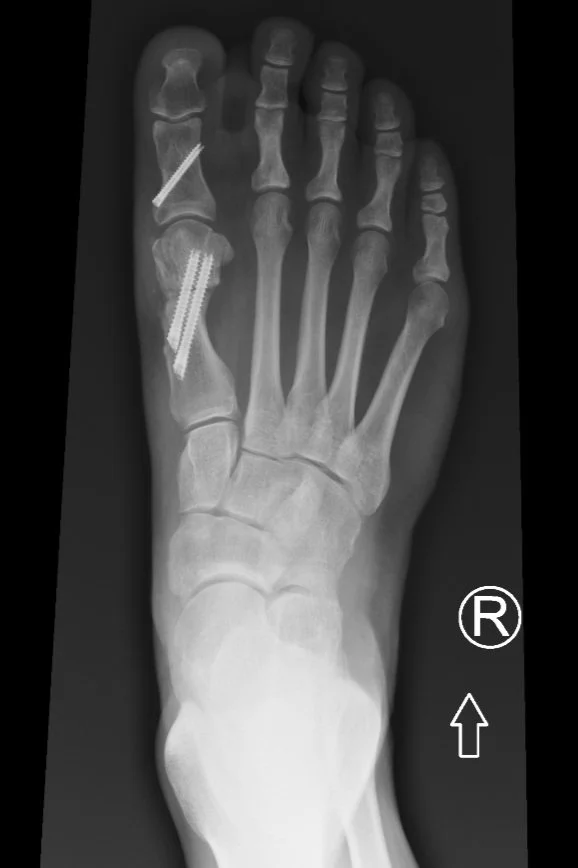When considering surgery for a bunion, many factors are taken into consideration prior to determining what the most appropriate option. A bunion is not simply a prominent bone nor is it a bony growth that can be easily taken off. In some cases, a patient believes they have a bunion, however, it may be a prominence on the top of the toe – that is related to arthritis. Some patients have a combination of both arthritis and a bunion that complicates the issue. In order to improve the function and appearance of the foot from a bunion (hallux valgus), the position of the 1st metatarsal (the prominent bone) must be shifted either by breaking the bone and fixing it with a screw, or fusing and realigning the joint called the 1st tarsometatarsal joint (Lapidus) surgery. Additionally the ligaments that help to stabilize the great toe are tightened to help maintain the position of the big toe as the ligaments on the inside of the foot have stretched out.
First and foremost, surgery for a bunion should only be considered if there is significant pain that interferes with activities of daily living that cannot be accommodated with shoe modification. Although this criteria can feel overly rigid, we have experience in treating patients from around the Midwest who have had prior bunion surgery that requires revision work. Understanding the difficulties they have had and the complex operations that are required to revise a failed bunion operation many that compromise motion of the toe, we encourage patients to only consider surgery if there is significant functional impairment to undertake the risks associated with surgery. We understand that the cosmetic appearance and fashionable shoes are an important consideration, however, given that the outcome from surgery is not perfect in every patient, we do not feel the benefits outweigh the risks in that case.
For bunions that are not severe, without arthritis and without any laxity (extra mobility of the middle of the foot) – a operation termed a Chevron osteotomy can be considered. This operation involves an incision on the side of the foot to expose the joint. The bone called the 1st metatarsal is surgical cut and shifted more towards the center of the foot and fixated with 1-2 screws. The ligaments on the outside of the joint that are tight are released and the inside ligament of the toe is tightened to realign the toe. In some cases, there is additional deformity of the phalanx (the smaller toe bone that forms the great toe joint) and this requires a small cut as well, taking out a small wedge of bone to realign the bone and this is fixed with a screw or surgical staple.
For more major bunions or those with laxity the preferred operation is called a Lapidus. A Lapidus was original described in 1934 and modernized with screw fixation use in 1973. Although some companies advocating their particular method of surgery imply that this is a new procedure developed a few years ago, this is quite incorrect. Modern techniques have evolved with more rigid fixation with pre-contoured plates and incorporating the concept of de-rotating the 1st metatarsal to aid in correction. There are many methods available to achieve fixation/stability of the fusion of the 1st TMT joint including screws, surgical staples and a combination of plates and screws. Regardless of the method chosen to achieve stability, the goal of surgery is to remove the cartilage from the 1st TMT joint (where the deformity is felt to be coming from) – realign the joint, place bone graft and hold the bones stable with fixation as described above. Additionally, the ligament on the inside of the foot is tightened and the outside ligaments of the big toe are lengthened. To help ensure healing of the bone we typically advocate 6 weeks no pressure on the foot, although this may vary based on the quality of the bone and type of fixation, with some patients being allowed to place pressure in the boot after 2-3 weeks.
There are risks with bunion surgery, anytime surgery is performed on a joint, there is a risk for stiffness and restriction of motions afterward. Scar tissue buildup inside the big toe joint is often the culprit. Bunions that have been present for many years may have some limited range of motion in the big toe joint after surgery because that joint was out-of-place for so long with the bunion, and even the realignment may not be able to restore the full motion. On average, a loss of motion of 15% is noted even after a successful bunion surgery. Other risks are recurrence of the bunion, hallux varus – where the toe drifts in the other direction, joint pain and dis-satisfaction with the cosmetic appearance of the toe.
To summarize, most patients are very satisfied with surgery for a symptomatic bunion, however, we try to minimize the risks to our patients and advocate non-surgical management if possible. Our goal is to ensure that patients are well informed so they can make the most appropriate decision for themselves.
